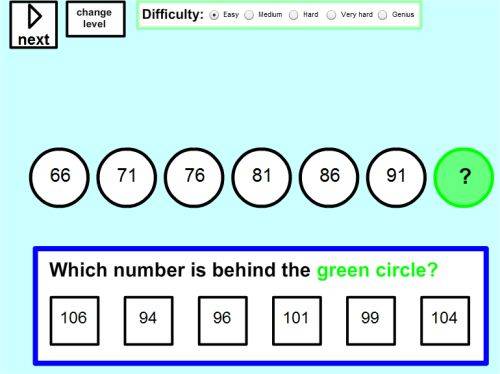Number Patterns & Sequences
Number patterns and sequences are sets of numbers that follow a specific rule or pattern. These patterns can be simple or complex, and they can be found in various mathematical contexts. Number patterns and sequences are often used in mathematics, computer science, and other fields to solve problems and make predictions.
Here are some common types of number patterns and sequences:
Arithmetic Sequence: An arithmetic sequence is a sequence of numbers in which the difference between consecutive terms is constant. For example, 2, 5, 8, 11, 14 is an arithmetic sequence with a common difference of 3.
Geometric Sequence: A geometric sequence is a sequence of numbers in which each term is found by multiplying the previous term by a constant factor. For example, 2, 6, 18, 54 is a geometric sequence with a common ratio of 3.
Fibonacci Sequence: The Fibonacci sequence is a sequence of numbers in which each term is the sum of the two preceding terms. It starts with 0 and 1, and the subsequent terms are obtained by adding the two previous terms. For example, the Fibonacci sequence begins as follows: 0, 1, 1, 2, 3, 5, 8, 13, 21, 34, and so on.
Square Numbers: Square numbers are the result of multiplying a number by itself. For example, 1, 4, 9, 16, 25, and so on are square numbers.
Prime Numbers: Prime numbers are numbers that are divisible only by 1 and themselves. For example, 2, 3, 5, 7, 11, and so on are prime numbers.
Pascal's Triangle: Pascal's triangle is a triangular array of numbers in which each number is the sum of the two numbers directly above it. The triangle starts with 1, and each row is constructed by adding the two numbers above it. Pascal's triangle can be used to find binomial coefficients and solve various mathematical problems.
These are just a few examples of number patterns and sequences. There are many more types and variations depending on the specific rules or relationships between the numbers. Exploring and understanding these patterns can help in problem-solving, mathematical reasoning, and developing a deeper understanding of numbers and their properties.
Square numbers
Square numbers are numbers that result from multiplying an integer by itself. In other words, they are the perfect squares of whole numbers. Square numbers have a distinct pattern: the sequence of square numbers is always increasing and the difference between consecutive square numbers is equal to the odd numbers.
Here are the first few square numbers:
1^2 = 1 2^2 = 4 3^2 = 9 4^2 = 16 5^2 = 25 6^2 = 36 7^2 = 49 8^2 = 64 9^2 = 81 10^2 = 100
As you can see, the square numbers are 1, 4, 9, 16, 25, 36, 49, 64, 81, 100, and so on.
Square numbers have several interesting properties:
The square of an odd number is always odd, and the square of an even number is always even.
The sum of consecutive odd numbers is always a square number. For example, 1 + 3 = 4 (2^2), 3 + 5 + 7 = 15 (3^2), 5 + 7 + 9 + 11 = 32 (4^2), and so on.
The sum of the first n odd numbers is always a square number. For example, the sum of the first 3 odd numbers (1 + 3 + 5) is 9 (3^2), and the sum of the first 4 odd numbers (1 + 3 + 5 + 7) is 16 (4^2).
The difference between consecutive square numbers is always equal to the corresponding odd number. For example, the difference between 4 (2^2) and 9 (3^2) is 5, the difference between 9 (3^2) and 16 (4^2) is 7, and so on.
Square numbers are used in various mathematical concepts and calculations, such as geometry, algebra, and number theory. They have many applications in fields like engineering, physics, and computer science.
Triangular numbers
Triangular numbers are a sequence of numbers that can be represented as the sum of consecutive positive integers starting from 1. Each triangular number represents the number of dots that can form an equilateral triangle.
The formula to calculate the nth triangular number is given by:
T_n = 1 + 2 + 3 + ... + n = n * (n + 1) / 2
Here are the first few triangular numbers:
T_1 = 1 T_2 = 1 + 2 = 3 T_3 = 1 + 2 + 3 = 6 T_4 = 1 + 2 + 3 + 4 = 10 T_5 = 1 + 2 + 3 + 4 + 5 = 15
The sequence of triangular numbers is 1, 3, 6, 10, 15, and so on.
Triangular numbers have some interesting properties:
The sum of consecutive triangular numbers forms a square number. For example, 1 + 3 = 4 (2^2), 3 + 6 = 9 (3^2), 6 + 10 = 16 (4^2), and so on.
The nth triangular number is the sum of the first n natural numbers. In other words, T_n = 1 + 2 + 3 + ... + n.
The difference between consecutive triangular numbers is always equal to the next natural number. For example, the difference between 3 and 6 is 3 (the next natural number after 2), the difference between 6 and 10 is 4 (the next natural number after 3), and so on.
Triangular numbers have applications in various areas of mathematics, such as combinatorics, algebra, and number theory. They can also be found in real-world situations, such as arranging objects in triangular patterns or calculating the number of elements in triangular grids.


